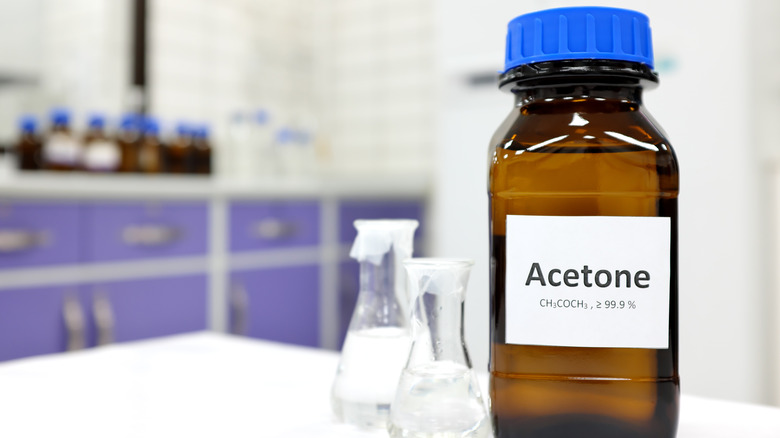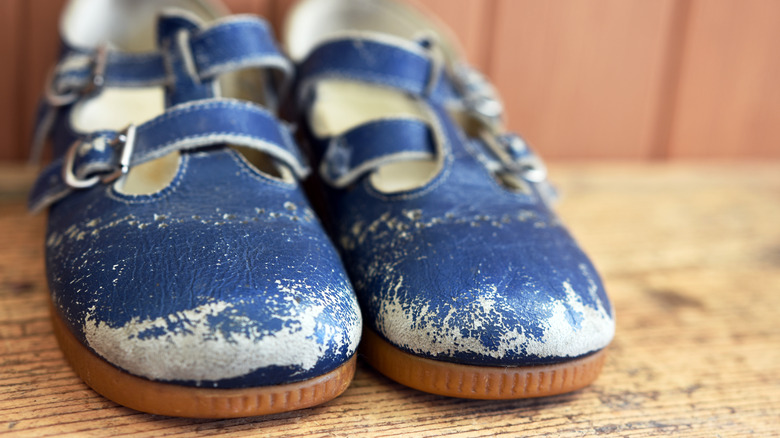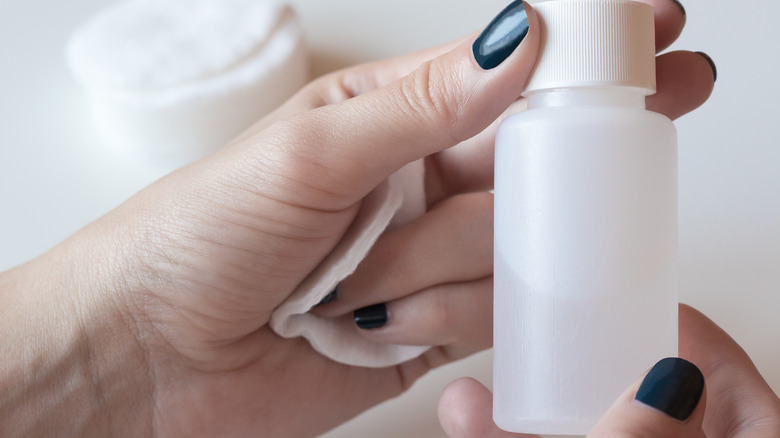The Most Important Place To Use Acetone That You're Probably Missing
In addition to a wide range of industrial uses, pharmaceutical applications, and a prominent place in chemistry, acetone is familiar to manicurists everywhere for its ability to remove nail polish. However, this solvent's role in household tasks, as well as dermatology and facial care is less well-known. For example, the solvent that strips paint removes stains, dissolves superglue, and reverses the effects of oil spills is a key component in facial treatments and chemical skin peels, OneHowTo notes. Surprisingly, your face is an unexpected place to use acetone.
Besides its use in facial and skin treatments, acetone has many other cosmetic applications. According to ReAgent, it is an ingredient in creams, lotions, hair dyes, baby wipes, and suntan products, and it can also be used to sanitize razor blades, tweezers, and nail clippers. The dry ice cryotherapy or "slush facial," popularized by Kendall and Kylie Jenner, is perhaps the trendiest use of acetone (via Refinery29). But what's the most important place in the home to use this versatile solvent?
Acetone vs. scuff marks
Acetone is a surprising and effective remedy for removing all sorts of unsightly scuff marks. Shoes, floors, and even car finishes can be revived using just a small amount of the solvent, a cotton ball, and a microfiber cloth. The discolorations caused by bumping or rubbing are no match for an acetone treatment; in fact, The Manual equates its effectiveness in erasing scuff marks with its vaunted nail polish removal ability.
Scuff marks on various materials and shoe types (suede excluded) are easy to eliminate. For safety's sake, Who What Wear recommends testing the acetone on a small, less visible part of the shoe. If okay, then proceed. Place a small amount on a cotton ball and polish the scuffs in tight, circular motions. Acetone works well on sneakers and dress shoes, and it's great for scuffed-up patent leather ones. Avoid over-applying, though, as too much might damage the finish. Top off the now scuff-free shoe with an application of mineral oil to complete the process.
According to Merry Maids, scuffed tile or laminate floors can be made look like new just by using a bit of acetone and a cloth. Provided a ding has not scratched or removed your car's paint, the offending mark can be rendered invisible using nail polish remover. Per Auto Revive, simply dampen a microfiber cloth and pass it lightly over the scuffed area. Repeat until the damage is gone.
More surprising uses of acetone
The versatile solvent has many other applications. Acetone is a remedy for a scratched watch face. It also works well to lift oil stains from a driveway; the process only requires a sawdust and acetone mixture covered with plastic wrap, says Craftsman Concrete. The solvent also cleans china and loosens unwanted stickers from glass. Cooktop Cove says that it can make bathtubs spotless, and you can even sanitize keyboards with it.
Furthermore, ArtRadarJournal recommends acetone for paint-stained tools, but you can also use it to prepare furniture for repainting. Golf recommends personalizing your irons, wedges, and putters with it. Prep with nail polish remover to remove existing paint, then redesign embossed areas using acetone-thinned paint. All Spray Painted suggests acetone spray to create artwork similar to watercolors. Misted on wet paint or using the aerosol and then moving the canvas produces a watercolor-like effect.
According to Patin-A, this versatile ingredient is also used to age or destroy props in movies or TV shows. Thanks to this many applications, acetone is a great item to have at home. Ensure you keep a bottle in your drawer, just like you do with vinegar.


